Human Resource Management: Attracting and Retaining Workforce
VerifiedAdded on 2021/05/31
|13
|3532
|27
Essay
AI Summary
This essay delves into the critical role of Human Resource Management (HRM) within the manufacturing sector, emphasizing the importance of attracting and retaining a skilled workforce. It explores key themes such as job design, highlighting the need for accurate job descriptions and the challenges of workforce shortages. The essay further examines HR planning, recruitment strategies, and the impact of diversity and work-life balance on employee satisfaction and retention. Challenges in performance management and the broader responsibilities of HRM, including administrative tasks and labor relations, are also discussed. The essay highlights the need for strategic HRM to address issues like skills gaps, recruitment difficulties, and employee turnover, ultimately contributing to organizational success in the manufacturing industry. It underscores the significance of adapting to technological advancements and evolving employee expectations to maintain a competitive edge.

0
Running head: HUMAN RESOURCE MANAGEMENT
Attracting and Retaining Staffs
Name of the Student:
Name of the University:
Author Note:
Running head: HUMAN RESOURCE MANAGEMENT
Attracting and Retaining Staffs
Name of the Student:
Name of the University:
Author Note:
Paraphrase This Document
Need a fresh take? Get an instant paraphrase of this document with our AI Paraphraser

1
HUMAN RESOURCE MANAGEMENT
Introduction
Many of the manufacturing companies are becoming much aware of necessity of
effective human resource management that contributes to achieve success in the business bottom
line. A manufacturing company establishes the effective human resource management to
encourage and create the positive work environment to develop the better working atmosphere
(Ulaga and Loveland, 2014). The human resource management needs to take the responsibility
of attracting and retaining the workforce within the workplace. For example, the HR manager
needs to structure the basic compensation for the associated workers, which creates the positive
impacts to retain the work force for the longer period. Similarly, the human resource
management needs to develop the better selection and recruitment process to hire the right
employee (Lieder & Rashid, 2016). The study will therefore concentrate on the thematic
evaluation of the human resource management responsibility in the manufacturing sector. The
underlying issues will be discussed in this study to understand the job role and effectiveness of
efficient Human Resource Management. The effective human resource management is
responsible for presenting the appropriate job design, appropriate human resource planning,
developing the recruitment and selection strategy, managing the diversity and the work life
balance, and improving the performance management. The essay will identify the associated
issues in manufacturing industry to develop these areas. Accordingly, the study will also discuss
the effectiveness of the human resource management to attract and retain the workforce despite
these key challenges.
Discussion
HUMAN RESOURCE MANAGEMENT
Introduction
Many of the manufacturing companies are becoming much aware of necessity of
effective human resource management that contributes to achieve success in the business bottom
line. A manufacturing company establishes the effective human resource management to
encourage and create the positive work environment to develop the better working atmosphere
(Ulaga and Loveland, 2014). The human resource management needs to take the responsibility
of attracting and retaining the workforce within the workplace. For example, the HR manager
needs to structure the basic compensation for the associated workers, which creates the positive
impacts to retain the work force for the longer period. Similarly, the human resource
management needs to develop the better selection and recruitment process to hire the right
employee (Lieder & Rashid, 2016). The study will therefore concentrate on the thematic
evaluation of the human resource management responsibility in the manufacturing sector. The
underlying issues will be discussed in this study to understand the job role and effectiveness of
efficient Human Resource Management. The effective human resource management is
responsible for presenting the appropriate job design, appropriate human resource planning,
developing the recruitment and selection strategy, managing the diversity and the work life
balance, and improving the performance management. The essay will identify the associated
issues in manufacturing industry to develop these areas. Accordingly, the study will also discuss
the effectiveness of the human resource management to attract and retain the workforce despite
these key challenges.
Discussion

2
HUMAN RESOURCE MANAGEMENT
One of the themes is Job Design, which is merely clarifying the job description of the
worker within a manufacturing sector. Human resource management in manufacturing industry
is responsible for collecting and developing the detailed information about the job specifications.
According to Vomberg, Homburg & Bornemann (2015), job design is one type of job analysis
process that defines the method of performing any functionality or task that are assigned to a
person within the workplace. This job design is associated with workflow design which analyses
the given task, which eventually produces any product or service. It is essential for the human
resource managers to identify the right person who is suitable enough to perform this work.
Selecting a job category will be much helpful in such aspects (Kerzner & Kerzner, 2017). In the
manufacturing industry one of the major issues is identified in work force selection. It has been
observed that there is the workforce shortage in manufacturing sector. The complexity of the job
role makes it too difficult for the human resource management to select the right candidate
(Bratton & Gold, 2017). The shortage of skills is probably one of the main reasons behind
it. Despite sustained and rapid financial growth, human resource management needs to address
the significant loss in developing the human capital in the manufacturing sector. There is
shortage of the skilled manufacturer, which is quite challenging for the human resource
management during their job allocation process. The manufacturing companies often find
difficulty to service in the competitive ground if there will be this much shortage of skilled
manufacturer (Marchington et al., 2016). It is thus necessary for the human resource
management to undertake the appropriate initiative to enhance your skills film suitable for
performing that job. For example, the vehicle manufacturer needs to develop their skills with the
technologies that are fulfilling the current demands of the customers while making the purchase
decisions. The lack of knowledge may affect the human resource practices in developing the
HUMAN RESOURCE MANAGEMENT
One of the themes is Job Design, which is merely clarifying the job description of the
worker within a manufacturing sector. Human resource management in manufacturing industry
is responsible for collecting and developing the detailed information about the job specifications.
According to Vomberg, Homburg & Bornemann (2015), job design is one type of job analysis
process that defines the method of performing any functionality or task that are assigned to a
person within the workplace. This job design is associated with workflow design which analyses
the given task, which eventually produces any product or service. It is essential for the human
resource managers to identify the right person who is suitable enough to perform this work.
Selecting a job category will be much helpful in such aspects (Kerzner & Kerzner, 2017). In the
manufacturing industry one of the major issues is identified in work force selection. It has been
observed that there is the workforce shortage in manufacturing sector. The complexity of the job
role makes it too difficult for the human resource management to select the right candidate
(Bratton & Gold, 2017). The shortage of skills is probably one of the main reasons behind
it. Despite sustained and rapid financial growth, human resource management needs to address
the significant loss in developing the human capital in the manufacturing sector. There is
shortage of the skilled manufacturer, which is quite challenging for the human resource
management during their job allocation process. The manufacturing companies often find
difficulty to service in the competitive ground if there will be this much shortage of skilled
manufacturer (Marchington et al., 2016). It is thus necessary for the human resource
management to undertake the appropriate initiative to enhance your skills film suitable for
performing that job. For example, the vehicle manufacturer needs to develop their skills with the
technologies that are fulfilling the current demands of the customers while making the purchase
decisions. The lack of knowledge may affect the human resource practices in developing the
⊘ This is a preview!⊘
Do you want full access?
Subscribe today to unlock all pages.

Trusted by 1+ million students worldwide
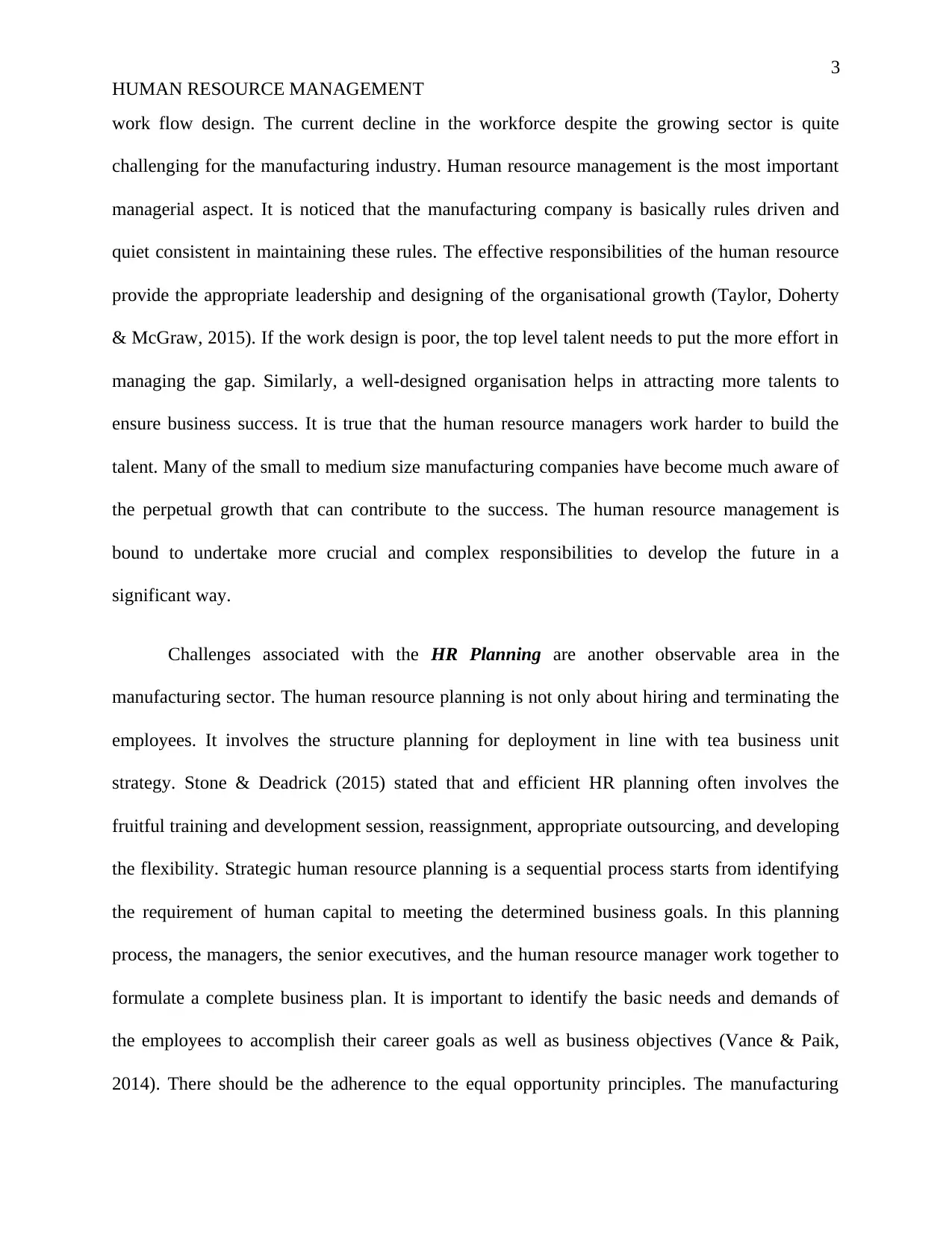
3
HUMAN RESOURCE MANAGEMENT
work flow design. The current decline in the workforce despite the growing sector is quite
challenging for the manufacturing industry. Human resource management is the most important
managerial aspect. It is noticed that the manufacturing company is basically rules driven and
quiet consistent in maintaining these rules. The effective responsibilities of the human resource
provide the appropriate leadership and designing of the organisational growth (Taylor, Doherty
& McGraw, 2015). If the work design is poor, the top level talent needs to put the more effort in
managing the gap. Similarly, a well-designed organisation helps in attracting more talents to
ensure business success. It is true that the human resource managers work harder to build the
talent. Many of the small to medium size manufacturing companies have become much aware of
the perpetual growth that can contribute to the success. The human resource management is
bound to undertake more crucial and complex responsibilities to develop the future in a
significant way.
Challenges associated with the HR Planning are another observable area in the
manufacturing sector. The human resource planning is not only about hiring and terminating the
employees. It involves the structure planning for deployment in line with tea business unit
strategy. Stone & Deadrick (2015) stated that and efficient HR planning often involves the
fruitful training and development session, reassignment, appropriate outsourcing, and developing
the flexibility. Strategic human resource planning is a sequential process starts from identifying
the requirement of human capital to meeting the determined business goals. In this planning
process, the managers, the senior executives, and the human resource manager work together to
formulate a complete business plan. It is important to identify the basic needs and demands of
the employees to accomplish their career goals as well as business objectives (Vance & Paik,
2014). There should be the adherence to the equal opportunity principles. The manufacturing
HUMAN RESOURCE MANAGEMENT
work flow design. The current decline in the workforce despite the growing sector is quite
challenging for the manufacturing industry. Human resource management is the most important
managerial aspect. It is noticed that the manufacturing company is basically rules driven and
quiet consistent in maintaining these rules. The effective responsibilities of the human resource
provide the appropriate leadership and designing of the organisational growth (Taylor, Doherty
& McGraw, 2015). If the work design is poor, the top level talent needs to put the more effort in
managing the gap. Similarly, a well-designed organisation helps in attracting more talents to
ensure business success. It is true that the human resource managers work harder to build the
talent. Many of the small to medium size manufacturing companies have become much aware of
the perpetual growth that can contribute to the success. The human resource management is
bound to undertake more crucial and complex responsibilities to develop the future in a
significant way.
Challenges associated with the HR Planning are another observable area in the
manufacturing sector. The human resource planning is not only about hiring and terminating the
employees. It involves the structure planning for deployment in line with tea business unit
strategy. Stone & Deadrick (2015) stated that and efficient HR planning often involves the
fruitful training and development session, reassignment, appropriate outsourcing, and developing
the flexibility. Strategic human resource planning is a sequential process starts from identifying
the requirement of human capital to meeting the determined business goals. In this planning
process, the managers, the senior executives, and the human resource manager work together to
formulate a complete business plan. It is important to identify the basic needs and demands of
the employees to accomplish their career goals as well as business objectives (Vance & Paik,
2014). There should be the adherence to the equal opportunity principles. The manufacturing
Paraphrase This Document
Need a fresh take? Get an instant paraphrase of this document with our AI Paraphraser
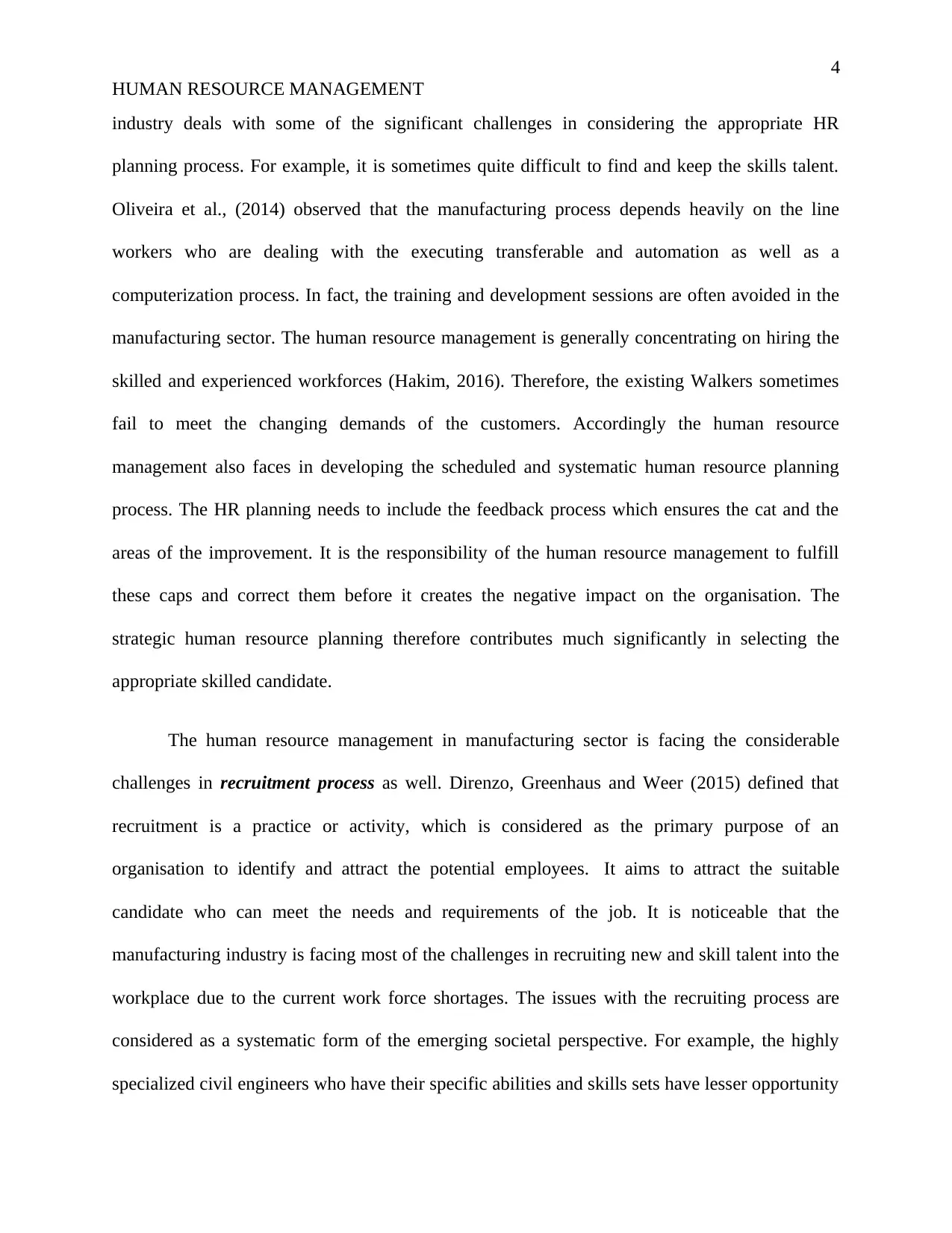
4
HUMAN RESOURCE MANAGEMENT
industry deals with some of the significant challenges in considering the appropriate HR
planning process. For example, it is sometimes quite difficult to find and keep the skills talent.
Oliveira et al., (2014) observed that the manufacturing process depends heavily on the line
workers who are dealing with the executing transferable and automation as well as a
computerization process. In fact, the training and development sessions are often avoided in the
manufacturing sector. The human resource management is generally concentrating on hiring the
skilled and experienced workforces (Hakim, 2016). Therefore, the existing Walkers sometimes
fail to meet the changing demands of the customers. Accordingly the human resource
management also faces in developing the scheduled and systematic human resource planning
process. The HR planning needs to include the feedback process which ensures the cat and the
areas of the improvement. It is the responsibility of the human resource management to fulfill
these caps and correct them before it creates the negative impact on the organisation. The
strategic human resource planning therefore contributes much significantly in selecting the
appropriate skilled candidate.
The human resource management in manufacturing sector is facing the considerable
challenges in recruitment process as well. Direnzo, Greenhaus and Weer (2015) defined that
recruitment is a practice or activity, which is considered as the primary purpose of an
organisation to identify and attract the potential employees. It aims to attract the suitable
candidate who can meet the needs and requirements of the job. It is noticeable that the
manufacturing industry is facing most of the challenges in recruiting new and skill talent into the
workplace due to the current work force shortages. The issues with the recruiting process are
considered as a systematic form of the emerging societal perspective. For example, the highly
specialized civil engineers who have their specific abilities and skills sets have lesser opportunity
HUMAN RESOURCE MANAGEMENT
industry deals with some of the significant challenges in considering the appropriate HR
planning process. For example, it is sometimes quite difficult to find and keep the skills talent.
Oliveira et al., (2014) observed that the manufacturing process depends heavily on the line
workers who are dealing with the executing transferable and automation as well as a
computerization process. In fact, the training and development sessions are often avoided in the
manufacturing sector. The human resource management is generally concentrating on hiring the
skilled and experienced workforces (Hakim, 2016). Therefore, the existing Walkers sometimes
fail to meet the changing demands of the customers. Accordingly the human resource
management also faces in developing the scheduled and systematic human resource planning
process. The HR planning needs to include the feedback process which ensures the cat and the
areas of the improvement. It is the responsibility of the human resource management to fulfill
these caps and correct them before it creates the negative impact on the organisation. The
strategic human resource planning therefore contributes much significantly in selecting the
appropriate skilled candidate.
The human resource management in manufacturing sector is facing the considerable
challenges in recruitment process as well. Direnzo, Greenhaus and Weer (2015) defined that
recruitment is a practice or activity, which is considered as the primary purpose of an
organisation to identify and attract the potential employees. It aims to attract the suitable
candidate who can meet the needs and requirements of the job. It is noticeable that the
manufacturing industry is facing most of the challenges in recruiting new and skill talent into the
workplace due to the current work force shortages. The issues with the recruiting process are
considered as a systematic form of the emerging societal perspective. For example, the highly
specialized civil engineers who have their specific abilities and skills sets have lesser opportunity
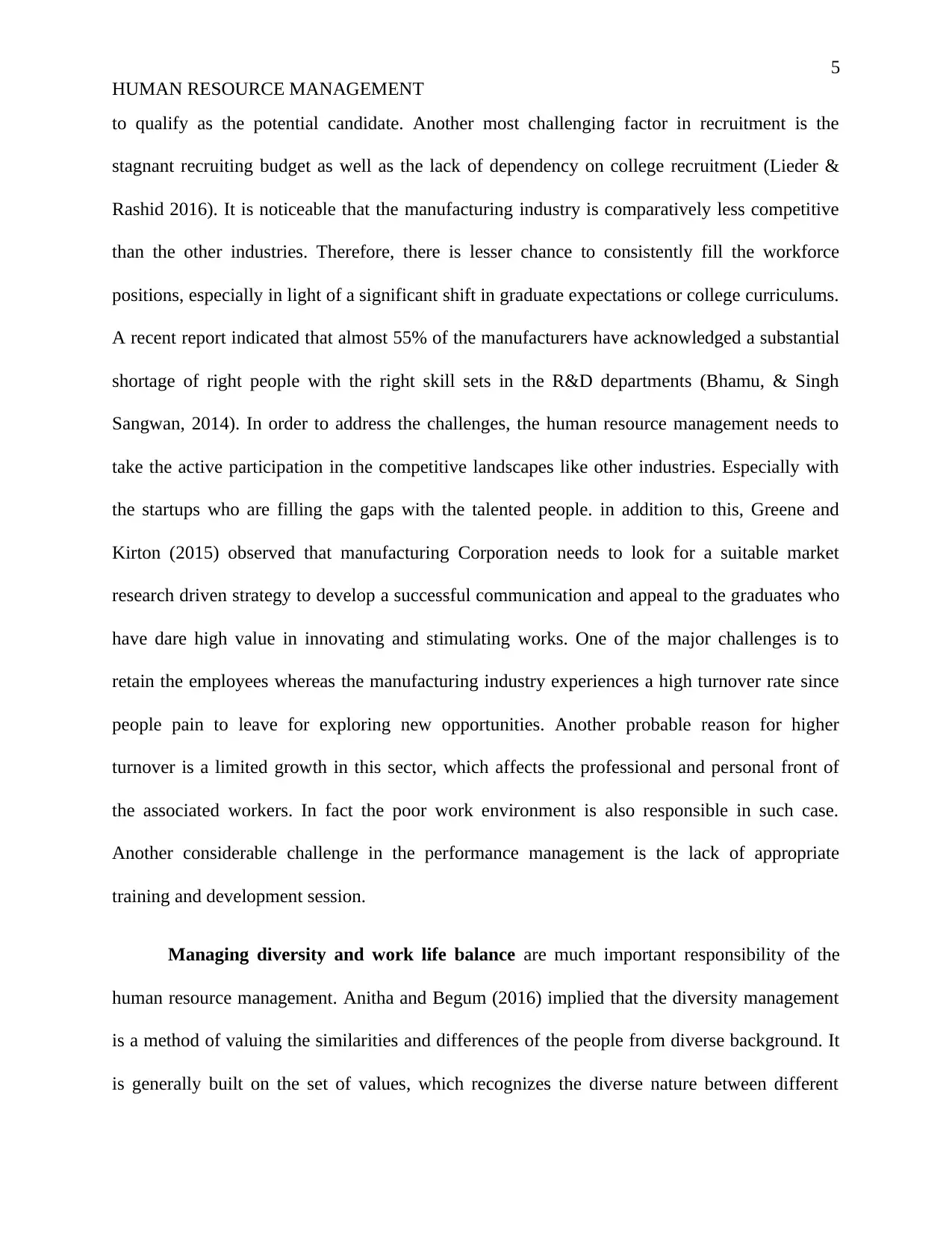
5
HUMAN RESOURCE MANAGEMENT
to qualify as the potential candidate. Another most challenging factor in recruitment is the
stagnant recruiting budget as well as the lack of dependency on college recruitment (Lieder &
Rashid 2016). It is noticeable that the manufacturing industry is comparatively less competitive
than the other industries. Therefore, there is lesser chance to consistently fill the workforce
positions, especially in light of a significant shift in graduate expectations or college curriculums.
A recent report indicated that almost 55% of the manufacturers have acknowledged a substantial
shortage of right people with the right skill sets in the R&D departments (Bhamu, & Singh
Sangwan, 2014). In order to address the challenges, the human resource management needs to
take the active participation in the competitive landscapes like other industries. Especially with
the startups who are filling the gaps with the talented people. in addition to this, Greene and
Kirton (2015) observed that manufacturing Corporation needs to look for a suitable market
research driven strategy to develop a successful communication and appeal to the graduates who
have dare high value in innovating and stimulating works. One of the major challenges is to
retain the employees whereas the manufacturing industry experiences a high turnover rate since
people pain to leave for exploring new opportunities. Another probable reason for higher
turnover is a limited growth in this sector, which affects the professional and personal front of
the associated workers. In fact the poor work environment is also responsible in such case.
Another considerable challenge in the performance management is the lack of appropriate
training and development session.
Managing diversity and work life balance are much important responsibility of the
human resource management. Anitha and Begum (2016) implied that the diversity management
is a method of valuing the similarities and differences of the people from diverse background. It
is generally built on the set of values, which recognizes the diverse nature between different
HUMAN RESOURCE MANAGEMENT
to qualify as the potential candidate. Another most challenging factor in recruitment is the
stagnant recruiting budget as well as the lack of dependency on college recruitment (Lieder &
Rashid 2016). It is noticeable that the manufacturing industry is comparatively less competitive
than the other industries. Therefore, there is lesser chance to consistently fill the workforce
positions, especially in light of a significant shift in graduate expectations or college curriculums.
A recent report indicated that almost 55% of the manufacturers have acknowledged a substantial
shortage of right people with the right skill sets in the R&D departments (Bhamu, & Singh
Sangwan, 2014). In order to address the challenges, the human resource management needs to
take the active participation in the competitive landscapes like other industries. Especially with
the startups who are filling the gaps with the talented people. in addition to this, Greene and
Kirton (2015) observed that manufacturing Corporation needs to look for a suitable market
research driven strategy to develop a successful communication and appeal to the graduates who
have dare high value in innovating and stimulating works. One of the major challenges is to
retain the employees whereas the manufacturing industry experiences a high turnover rate since
people pain to leave for exploring new opportunities. Another probable reason for higher
turnover is a limited growth in this sector, which affects the professional and personal front of
the associated workers. In fact the poor work environment is also responsible in such case.
Another considerable challenge in the performance management is the lack of appropriate
training and development session.
Managing diversity and work life balance are much important responsibility of the
human resource management. Anitha and Begum (2016) implied that the diversity management
is a method of valuing the similarities and differences of the people from diverse background. It
is generally built on the set of values, which recognizes the diverse nature between different
⊘ This is a preview!⊘
Do you want full access?
Subscribe today to unlock all pages.

Trusted by 1+ million students worldwide
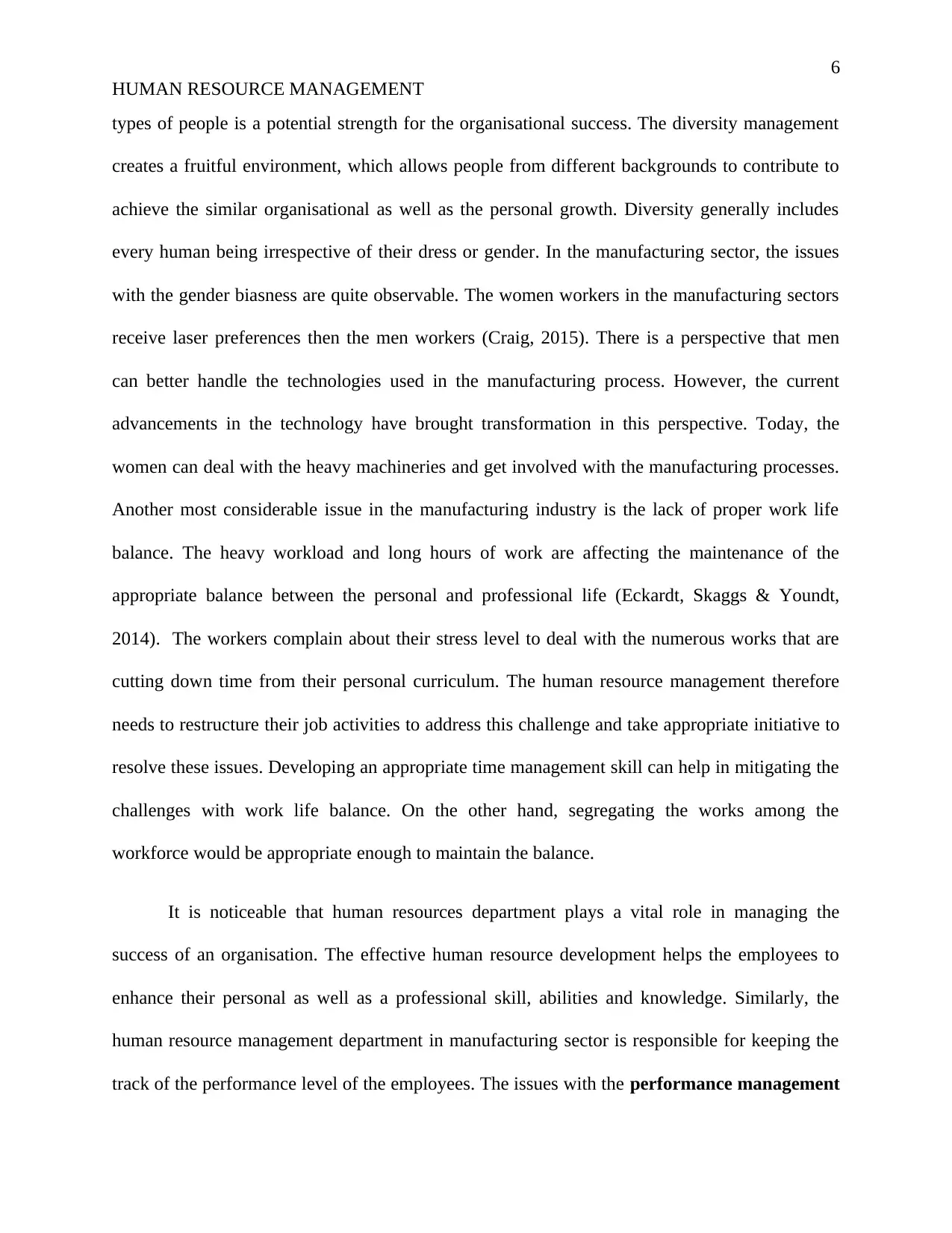
6
HUMAN RESOURCE MANAGEMENT
types of people is a potential strength for the organisational success. The diversity management
creates a fruitful environment, which allows people from different backgrounds to contribute to
achieve the similar organisational as well as the personal growth. Diversity generally includes
every human being irrespective of their dress or gender. In the manufacturing sector, the issues
with the gender biasness are quite observable. The women workers in the manufacturing sectors
receive laser preferences then the men workers (Craig, 2015). There is a perspective that men
can better handle the technologies used in the manufacturing process. However, the current
advancements in the technology have brought transformation in this perspective. Today, the
women can deal with the heavy machineries and get involved with the manufacturing processes.
Another most considerable issue in the manufacturing industry is the lack of proper work life
balance. The heavy workload and long hours of work are affecting the maintenance of the
appropriate balance between the personal and professional life (Eckardt, Skaggs & Youndt,
2014). The workers complain about their stress level to deal with the numerous works that are
cutting down time from their personal curriculum. The human resource management therefore
needs to restructure their job activities to address this challenge and take appropriate initiative to
resolve these issues. Developing an appropriate time management skill can help in mitigating the
challenges with work life balance. On the other hand, segregating the works among the
workforce would be appropriate enough to maintain the balance.
It is noticeable that human resources department plays a vital role in managing the
success of an organisation. The effective human resource development helps the employees to
enhance their personal as well as a professional skill, abilities and knowledge. Similarly, the
human resource management department in manufacturing sector is responsible for keeping the
track of the performance level of the employees. The issues with the performance management
HUMAN RESOURCE MANAGEMENT
types of people is a potential strength for the organisational success. The diversity management
creates a fruitful environment, which allows people from different backgrounds to contribute to
achieve the similar organisational as well as the personal growth. Diversity generally includes
every human being irrespective of their dress or gender. In the manufacturing sector, the issues
with the gender biasness are quite observable. The women workers in the manufacturing sectors
receive laser preferences then the men workers (Craig, 2015). There is a perspective that men
can better handle the technologies used in the manufacturing process. However, the current
advancements in the technology have brought transformation in this perspective. Today, the
women can deal with the heavy machineries and get involved with the manufacturing processes.
Another most considerable issue in the manufacturing industry is the lack of proper work life
balance. The heavy workload and long hours of work are affecting the maintenance of the
appropriate balance between the personal and professional life (Eckardt, Skaggs & Youndt,
2014). The workers complain about their stress level to deal with the numerous works that are
cutting down time from their personal curriculum. The human resource management therefore
needs to restructure their job activities to address this challenge and take appropriate initiative to
resolve these issues. Developing an appropriate time management skill can help in mitigating the
challenges with work life balance. On the other hand, segregating the works among the
workforce would be appropriate enough to maintain the balance.
It is noticeable that human resources department plays a vital role in managing the
success of an organisation. The effective human resource development helps the employees to
enhance their personal as well as a professional skill, abilities and knowledge. Similarly, the
human resource management department in manufacturing sector is responsible for keeping the
track of the performance level of the employees. The issues with the performance management
Paraphrase This Document
Need a fresh take? Get an instant paraphrase of this document with our AI Paraphraser
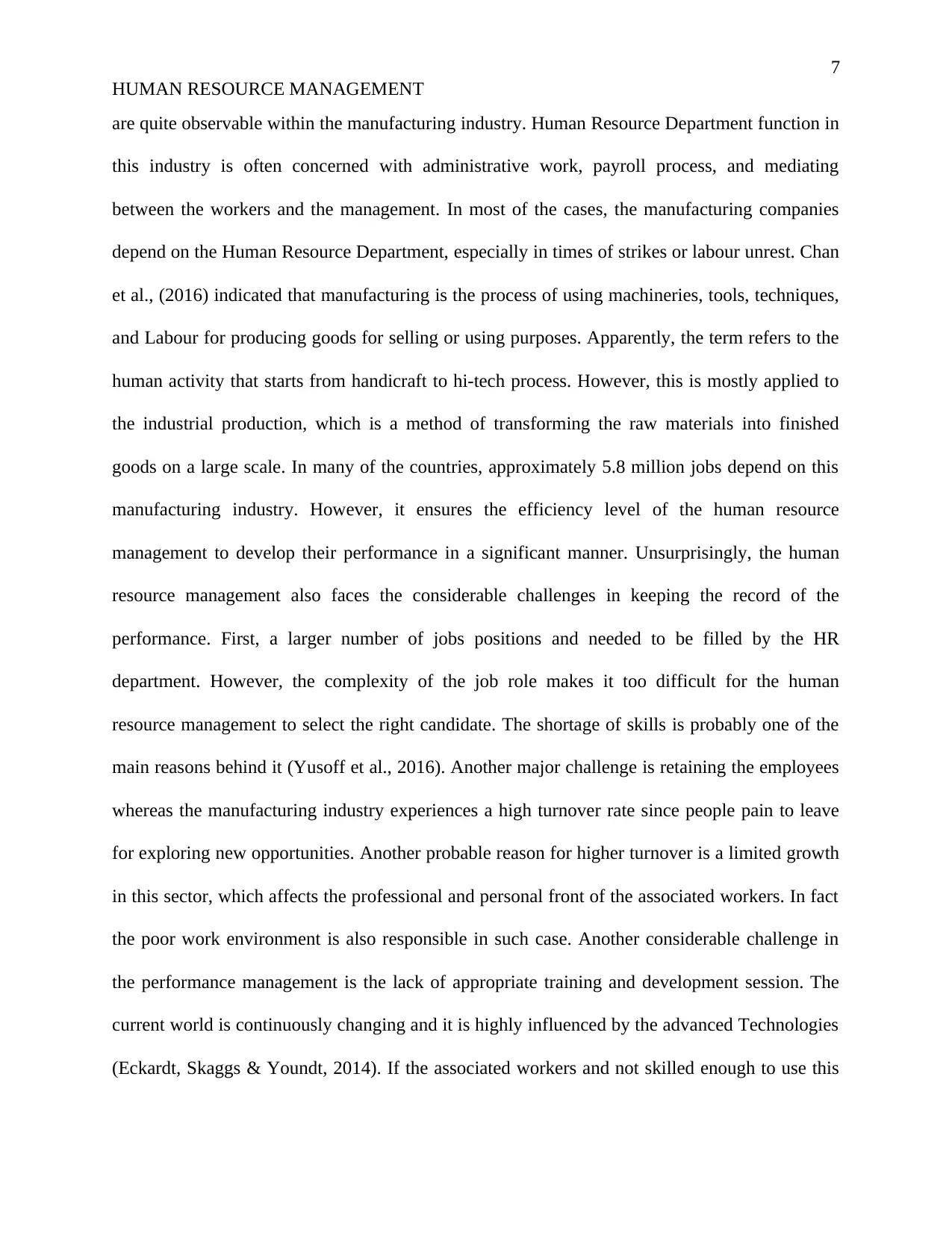
7
HUMAN RESOURCE MANAGEMENT
are quite observable within the manufacturing industry. Human Resource Department function in
this industry is often concerned with administrative work, payroll process, and mediating
between the workers and the management. In most of the cases, the manufacturing companies
depend on the Human Resource Department, especially in times of strikes or labour unrest. Chan
et al., (2016) indicated that manufacturing is the process of using machineries, tools, techniques,
and Labour for producing goods for selling or using purposes. Apparently, the term refers to the
human activity that starts from handicraft to hi-tech process. However, this is mostly applied to
the industrial production, which is a method of transforming the raw materials into finished
goods on a large scale. In many of the countries, approximately 5.8 million jobs depend on this
manufacturing industry. However, it ensures the efficiency level of the human resource
management to develop their performance in a significant manner. Unsurprisingly, the human
resource management also faces the considerable challenges in keeping the record of the
performance. First, a larger number of jobs positions and needed to be filled by the HR
department. However, the complexity of the job role makes it too difficult for the human
resource management to select the right candidate. The shortage of skills is probably one of the
main reasons behind it (Yusoff et al., 2016). Another major challenge is retaining the employees
whereas the manufacturing industry experiences a high turnover rate since people pain to leave
for exploring new opportunities. Another probable reason for higher turnover is a limited growth
in this sector, which affects the professional and personal front of the associated workers. In fact
the poor work environment is also responsible in such case. Another considerable challenge in
the performance management is the lack of appropriate training and development session. The
current world is continuously changing and it is highly influenced by the advanced Technologies
(Eckardt, Skaggs & Youndt, 2014). If the associated workers and not skilled enough to use this
HUMAN RESOURCE MANAGEMENT
are quite observable within the manufacturing industry. Human Resource Department function in
this industry is often concerned with administrative work, payroll process, and mediating
between the workers and the management. In most of the cases, the manufacturing companies
depend on the Human Resource Department, especially in times of strikes or labour unrest. Chan
et al., (2016) indicated that manufacturing is the process of using machineries, tools, techniques,
and Labour for producing goods for selling or using purposes. Apparently, the term refers to the
human activity that starts from handicraft to hi-tech process. However, this is mostly applied to
the industrial production, which is a method of transforming the raw materials into finished
goods on a large scale. In many of the countries, approximately 5.8 million jobs depend on this
manufacturing industry. However, it ensures the efficiency level of the human resource
management to develop their performance in a significant manner. Unsurprisingly, the human
resource management also faces the considerable challenges in keeping the record of the
performance. First, a larger number of jobs positions and needed to be filled by the HR
department. However, the complexity of the job role makes it too difficult for the human
resource management to select the right candidate. The shortage of skills is probably one of the
main reasons behind it (Yusoff et al., 2016). Another major challenge is retaining the employees
whereas the manufacturing industry experiences a high turnover rate since people pain to leave
for exploring new opportunities. Another probable reason for higher turnover is a limited growth
in this sector, which affects the professional and personal front of the associated workers. In fact
the poor work environment is also responsible in such case. Another considerable challenge in
the performance management is the lack of appropriate training and development session. The
current world is continuously changing and it is highly influenced by the advanced Technologies
(Eckardt, Skaggs & Youndt, 2014). If the associated workers and not skilled enough to use this
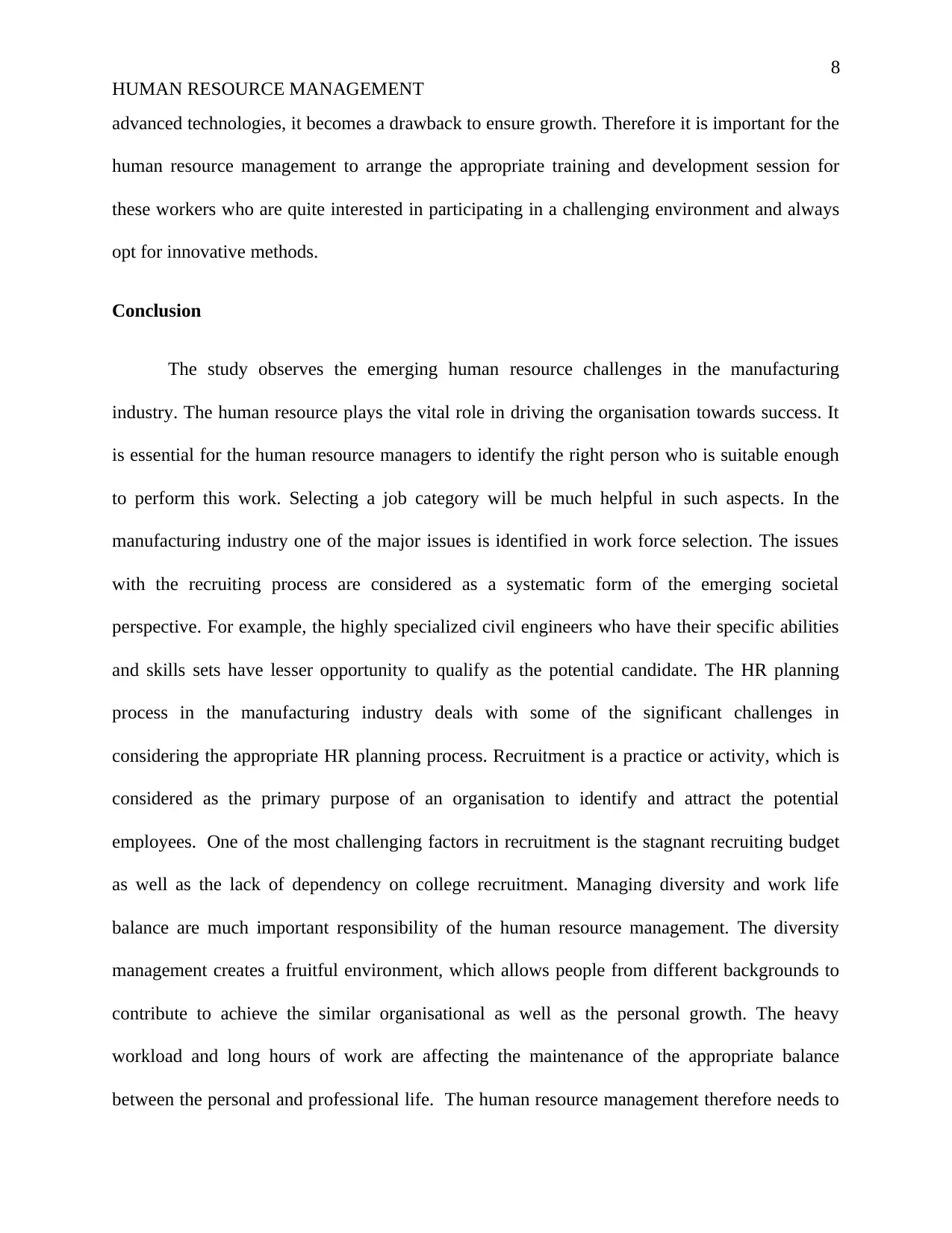
8
HUMAN RESOURCE MANAGEMENT
advanced technologies, it becomes a drawback to ensure growth. Therefore it is important for the
human resource management to arrange the appropriate training and development session for
these workers who are quite interested in participating in a challenging environment and always
opt for innovative methods.
Conclusion
The study observes the emerging human resource challenges in the manufacturing
industry. The human resource plays the vital role in driving the organisation towards success. It
is essential for the human resource managers to identify the right person who is suitable enough
to perform this work. Selecting a job category will be much helpful in such aspects. In the
manufacturing industry one of the major issues is identified in work force selection. The issues
with the recruiting process are considered as a systematic form of the emerging societal
perspective. For example, the highly specialized civil engineers who have their specific abilities
and skills sets have lesser opportunity to qualify as the potential candidate. The HR planning
process in the manufacturing industry deals with some of the significant challenges in
considering the appropriate HR planning process. Recruitment is a practice or activity, which is
considered as the primary purpose of an organisation to identify and attract the potential
employees. One of the most challenging factors in recruitment is the stagnant recruiting budget
as well as the lack of dependency on college recruitment. Managing diversity and work life
balance are much important responsibility of the human resource management. The diversity
management creates a fruitful environment, which allows people from different backgrounds to
contribute to achieve the similar organisational as well as the personal growth. The heavy
workload and long hours of work are affecting the maintenance of the appropriate balance
between the personal and professional life. The human resource management therefore needs to
HUMAN RESOURCE MANAGEMENT
advanced technologies, it becomes a drawback to ensure growth. Therefore it is important for the
human resource management to arrange the appropriate training and development session for
these workers who are quite interested in participating in a challenging environment and always
opt for innovative methods.
Conclusion
The study observes the emerging human resource challenges in the manufacturing
industry. The human resource plays the vital role in driving the organisation towards success. It
is essential for the human resource managers to identify the right person who is suitable enough
to perform this work. Selecting a job category will be much helpful in such aspects. In the
manufacturing industry one of the major issues is identified in work force selection. The issues
with the recruiting process are considered as a systematic form of the emerging societal
perspective. For example, the highly specialized civil engineers who have their specific abilities
and skills sets have lesser opportunity to qualify as the potential candidate. The HR planning
process in the manufacturing industry deals with some of the significant challenges in
considering the appropriate HR planning process. Recruitment is a practice or activity, which is
considered as the primary purpose of an organisation to identify and attract the potential
employees. One of the most challenging factors in recruitment is the stagnant recruiting budget
as well as the lack of dependency on college recruitment. Managing diversity and work life
balance are much important responsibility of the human resource management. The diversity
management creates a fruitful environment, which allows people from different backgrounds to
contribute to achieve the similar organisational as well as the personal growth. The heavy
workload and long hours of work are affecting the maintenance of the appropriate balance
between the personal and professional life. The human resource management therefore needs to
⊘ This is a preview!⊘
Do you want full access?
Subscribe today to unlock all pages.

Trusted by 1+ million students worldwide
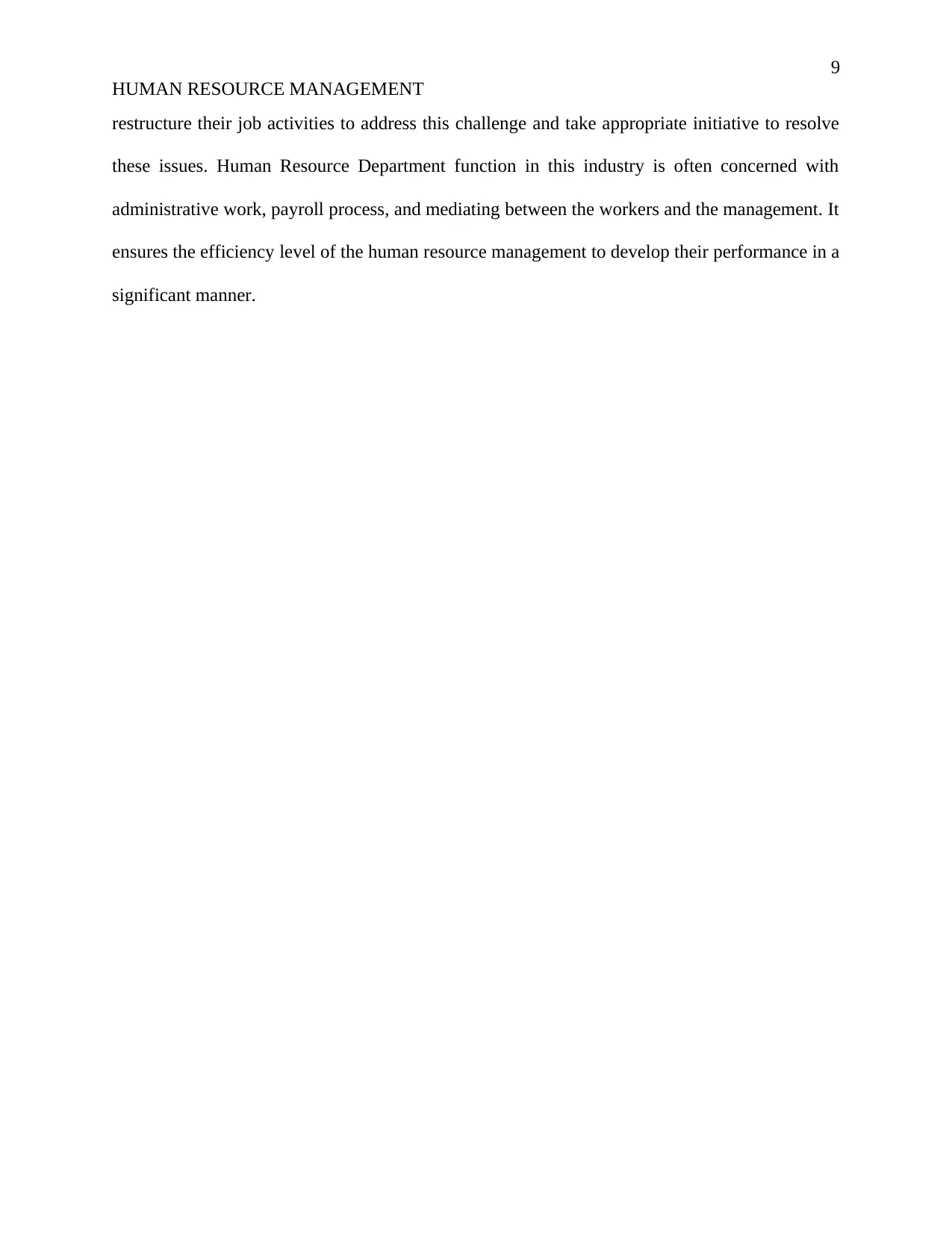
9
HUMAN RESOURCE MANAGEMENT
restructure their job activities to address this challenge and take appropriate initiative to resolve
these issues. Human Resource Department function in this industry is often concerned with
administrative work, payroll process, and mediating between the workers and the management. It
ensures the efficiency level of the human resource management to develop their performance in a
significant manner.
HUMAN RESOURCE MANAGEMENT
restructure their job activities to address this challenge and take appropriate initiative to resolve
these issues. Human Resource Department function in this industry is often concerned with
administrative work, payroll process, and mediating between the workers and the management. It
ensures the efficiency level of the human resource management to develop their performance in a
significant manner.
Paraphrase This Document
Need a fresh take? Get an instant paraphrase of this document with our AI Paraphraser

10
HUMAN RESOURCE MANAGEMENT
References
Anitha, J. & Begum, F.N., (2016). Role of organisational culture and employee commitment in
employee retention. ASBM Journal of Management, 9(1), p.17.
Bhamu, J. & Singh Sangwan, K., (2014). Lean manufacturing: literature review and research
issues. International Journal of Operations & Production Management, 34(7), pp.876-
940.
Bratton, J. and Gold, J., (2017). Human resource management: theory and practice. Palgrave.
Chan, S.W., Omar, A.R., Ramlan, R., Zaman, I., Omar, S.S. & Lim, K.H., (2016, May).
Assessing Participation in Decision-Making among Employees in the Manufacturing
Industry. In Industrial Engineering, Management Science and Application (ICIMSA),
2016 International Conference on (pp. 1-5). IEEE.
Craig, M., (2015, July). Cost effectiveness of retaining top internal talent in contrast to recruiting
top talent. In Competition Forum (Vol. 13, No. 2, p. 203). American Society for
Competitiveness.
Direnzo, M.S., Greenhaus, J.H. & Weer, C.H., (2015). Relationship between protean career
orientation and work–life balance: A resource perspective. Journal of Organizational
Behavior, 36(4), pp.538-560.
Eckardt, R., Skaggs, B.C. & Youndt, M., (2014). Turnover and knowledge loss: An examination
of the differential impact of production manager and worker turnover in service and
manufacturing firms. Journal of Management Studies, 51(7), pp.1025-1057.
HUMAN RESOURCE MANAGEMENT
References
Anitha, J. & Begum, F.N., (2016). Role of organisational culture and employee commitment in
employee retention. ASBM Journal of Management, 9(1), p.17.
Bhamu, J. & Singh Sangwan, K., (2014). Lean manufacturing: literature review and research
issues. International Journal of Operations & Production Management, 34(7), pp.876-
940.
Bratton, J. and Gold, J., (2017). Human resource management: theory and practice. Palgrave.
Chan, S.W., Omar, A.R., Ramlan, R., Zaman, I., Omar, S.S. & Lim, K.H., (2016, May).
Assessing Participation in Decision-Making among Employees in the Manufacturing
Industry. In Industrial Engineering, Management Science and Application (ICIMSA),
2016 International Conference on (pp. 1-5). IEEE.
Craig, M., (2015, July). Cost effectiveness of retaining top internal talent in contrast to recruiting
top talent. In Competition Forum (Vol. 13, No. 2, p. 203). American Society for
Competitiveness.
Direnzo, M.S., Greenhaus, J.H. & Weer, C.H., (2015). Relationship between protean career
orientation and work–life balance: A resource perspective. Journal of Organizational
Behavior, 36(4), pp.538-560.
Eckardt, R., Skaggs, B.C. & Youndt, M., (2014). Turnover and knowledge loss: An examination
of the differential impact of production manager and worker turnover in service and
manufacturing firms. Journal of Management Studies, 51(7), pp.1025-1057.

11
HUMAN RESOURCE MANAGEMENT
Greene, A.M. and Kirton, G., (2015). The dynamics of managing diversity: A critical approach.
Routledge.
Hakim, C., (2016). Key issues in women's work: Female diversity and the polarisation of
women's employment. Routledge-Cavendish.
Kerzner, H. and Kerzner, H.R., (2017). Project management: a systems approach to planning,
scheduling, and controlling. John Wiley & Sons.
Lieder, M. & Rashid, A., (2016). Towards circular economy implementation: a comprehensive
review in context of manufacturing industry. Journal of Cleaner Production, 115, pp.36-
51.
Lieder, M. and Rashid, A., (2016). Towards circular economy implementation: a comprehensive
review in context of manufacturing industry. Journal of Cleaner Production, 115, pp.36-
51.
Marchington, M., Wilkinson, A., Donnelly, R. & Kynighou, A., (2016). Human resource
management at work. Kogan Page Publishers.
Oliveira, T., Thomas, M. and Espadanal, M., (2014). Assessing the determinants of cloud
computing adoption: An analysis of the manufacturing and services sectors. Information
& Management, 51(5), pp.497-510.
Stone, D.L. & Deadrick, D.L., (2015). Challenges and opportunities affecting the future of
human resource management. Human Resource Management Review, 25(2), pp.139-145.
Taylor, T., Doherty, A. & McGraw, P., (2015). Managing people in sport organizations: A
strategic human resource management perspective. Routledge.
HUMAN RESOURCE MANAGEMENT
Greene, A.M. and Kirton, G., (2015). The dynamics of managing diversity: A critical approach.
Routledge.
Hakim, C., (2016). Key issues in women's work: Female diversity and the polarisation of
women's employment. Routledge-Cavendish.
Kerzner, H. and Kerzner, H.R., (2017). Project management: a systems approach to planning,
scheduling, and controlling. John Wiley & Sons.
Lieder, M. & Rashid, A., (2016). Towards circular economy implementation: a comprehensive
review in context of manufacturing industry. Journal of Cleaner Production, 115, pp.36-
51.
Lieder, M. and Rashid, A., (2016). Towards circular economy implementation: a comprehensive
review in context of manufacturing industry. Journal of Cleaner Production, 115, pp.36-
51.
Marchington, M., Wilkinson, A., Donnelly, R. & Kynighou, A., (2016). Human resource
management at work. Kogan Page Publishers.
Oliveira, T., Thomas, M. and Espadanal, M., (2014). Assessing the determinants of cloud
computing adoption: An analysis of the manufacturing and services sectors. Information
& Management, 51(5), pp.497-510.
Stone, D.L. & Deadrick, D.L., (2015). Challenges and opportunities affecting the future of
human resource management. Human Resource Management Review, 25(2), pp.139-145.
Taylor, T., Doherty, A. & McGraw, P., (2015). Managing people in sport organizations: A
strategic human resource management perspective. Routledge.
⊘ This is a preview!⊘
Do you want full access?
Subscribe today to unlock all pages.

Trusted by 1+ million students worldwide
1 out of 13
Related Documents
Your All-in-One AI-Powered Toolkit for Academic Success.
+13062052269
info@desklib.com
Available 24*7 on WhatsApp / Email
![[object Object]](/_next/static/media/star-bottom.7253800d.svg)
Unlock your academic potential
Copyright © 2020–2025 A2Z Services. All Rights Reserved. Developed and managed by ZUCOL.




